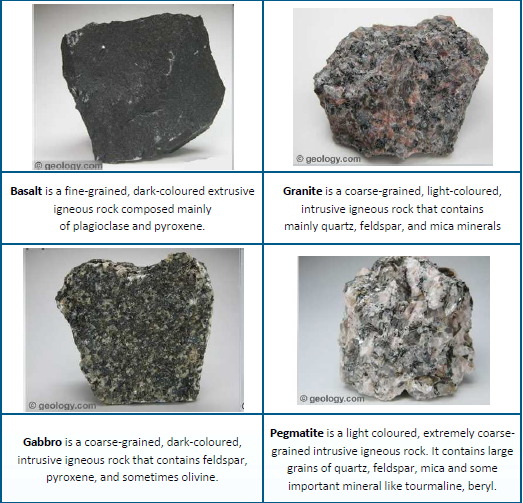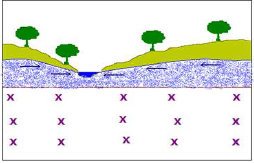Understanding Aquifers and Ground Water Movement
Understanding Aquifers and Ground Water Movement
Aquifer – The Reservoir for Ground Water
Geological formations that yield sufficient water are known as aquifers. They are formations porous and permeable enough to sustain economic exploitation of ground water. They have vast aerial extent where ground water flows under gravity at a very slow pace. Commonly sand, gravel and pebbles serve as good aquifers in the alluvial/coastal areas while fractured and weathered zone developed on a massive rock proves as potential aquifer systems in the hard rock terrains.
Types of Rocks and their Properties
Ground water is stored in the fractures of rocky formation and within the pore spaces of unconsolidated formations. However, the wider fracture / pore size facilitates more storage of ground water. Further, the water bearing capacity depends on the degree of consolidation of rocks. There are three basic types of rocks on earth - Igneous rock, Sedimentary rock and Metamorphic rock The different types of rocks and their relevance with respect to ground water are discussed below.
Igneous rocks
- Formed out of magma and lava and are known as primary rocks.
- If molten material is cooled slowly at great depths, mineral grains may be very large.
- Sudden cooling (at the surface) results in small and smooth grains.
- Granite, gabbro, Rhyolite, pegmatite, basalt, etc. are some of the examples of igneous rocks.
Sedimentary rocks
- Sedimentary or detrital rocks formed as a result of denudation of igneous and metamorphic rocks (by weathering and erosion).
- These deposits through compaction turn into rocks. This process is called lithification.
- Cover 75 per cent of the earth’s crust but volumetrically occupy only 5 percent.
- They are layered or stratified formations of varying thickness. Example, sandstone, shale etc.
Metamorphic rocks
- The word metamorphic means ‘change of form’. Formed under the action of pressure, volume and temperature (PVT) changes.
- Metamorphism occurs when rocks are forced down to lower levels by tectonic processes or when molten magma rising through the crust comes in contact with the crustal rocks.
- Metamorphism is a process by which already consolidated rocks undergo recrystallization and reorganization of materials within original rocks.
- In the process of metamorphism in some rocks grains or minerals get arranged in layers or lines. Such an arrangement is called foliation or lineation. Sometimes minerals or materials of different groups are arranged into alternating thin to thick layers. Such a structure in is called banding.
- Gneiss, slate, schist, marble, quartzite etc. are some examples of metamorphic rocks.

.png)
.png)
.png)
.png)
.png)
Fractures
Fractures occur in massive rocks due to breaking under differential stress conditions. Two parameters influence fracture patterns: the orientation of the fractures and their frequencies. Orientation of fractures is based on the state of stress within the rock i.e. both stress difference and orientation of the principal stresses. In contrast, the frequency or spacing of fractures is based on the properties of the rocks in which the fractures have formed. Fractures play an important role in the occurrence and movement of ground water in an otherwise massive rock formation.
Types of Soils
Soil develops slowly over time and is composed of many different materials. Inorganic materials, or those materials that are not living, include weathered rocks and minerals. Soil comprises of solids and voids space. Voids include air and water. When rainwater get infiltrate, it occupies and move through void space. If the voids spaces are completely filled with water means soil is fully saturated. Basically, there are 4 basic types of soils on the earth;
Sandy soil consists of small particles of weathered rock. It is fairly coarse and loose so water is able to drain through it easily. While this is good for drainage, it is not good for growing plants because sandy soil will not hold water or nutrients.
Silty Soil consists of fine sand and will hold water better than sand. When a handful of dry silt is held in hand, it would feel almost like flour and if water is added, it would do a fair job of holding the water and feels slick and smooth.
.png)
Clayey Soil is very fine-grained, its particles are even smaller than silt. Hence, there is little space between the fine grains for air or water to circulate. Therefore, clay does not drain well.
Loamy Soil is a mixture of clay, sand and silt soils. Its nature will vary depending on how much of each component is present, but generally provides good drainage.
Ground water Movement
 Ground water constitutes one portion of this water circulatory system. Water bearing geological formations on the earth’s crust act as reservoirs for storage of water and conduits for its transmission. The process of receiving water by the ground water reservoir is called ground water recharge. Water enters these formations from the ground surface by percolation, after which it travels slowly for varying distances until it returns to the surface by action of natural flow under gravity.
Ground water constitutes one portion of this water circulatory system. Water bearing geological formations on the earth’s crust act as reservoirs for storage of water and conduits for its transmission. The process of receiving water by the ground water reservoir is called ground water recharge. Water enters these formations from the ground surface by percolation, after which it travels slowly for varying distances until it returns to the surface by action of natural flow under gravity.
Ground water flows at a slow pace under the influence of gravity and horizontal flow is the dominant component. The flow of ground water depends on the permeability of the aquifer and the hydraulic gradient of the water table/piezometric surface. While water flows a few kilometres in a day on the surface, the same passes only a few meters in highly permeable sand and gravelly formation under a hydraulic gradient same that of the land slope.
Effects of Pumping on Ground Water
When a well is pumped, water level in the well starts declining with time at a faster rate during early pumping and stabilizing later. The difference of pumping water level from the static one is called drawdown (DD).
.png)
During pumping ground water rushes towards the well from the aquifer under the impact of drawdown and the water table / piezometric surface forms an inverted cone. The spread of the cone is more in confined aquifer than in unconfined one. Thus the impact of pumping is felt in areas overlying this cone of pumping. Generally, this cone spreads with the duration of pumping and hence long duration pumping definitely have impact on nearby wells tapping the same aquifer. However, pumping from dug well will have little impact on the neighbourhood.
Ground Water Quality
The quality of water is defined as its acceptability with respect to its specific uses. A suitable quality of water is one whose characteristics make it acceptable to the needs of the water.
It can be completely defined and estimated by studying it’s physical, chemical and bacteriological characteristics.
Physical Characteristics
Turbidity: Turbidity of water is a measure of the cloudiness. It is caused by the presence of clays or suspended matters which scatters and absorbs light and appears muddy or turbid. The turbidity depends upon the fineness and concentration of particles present in water. Turbidity is measured in laboratory with the help of an instrument called Turbidity meter which works on the principle of measuring the interference caused by water sample to the passage of light rays. The standard turbidity of 1 unit (1mg/l) is that turbidity which is caused by 1 mg of silica (SiO2) in 1 litre of distilled water.
Colour: Generally, ground water is colourless. But if its appearance is coloured then it may be due to certain impurities which may be due to presence of coloured organic substances or due to the presence of metals such as iron, manganese and copper, which are abundant in nature. Taste and Odours: Clear water is tasteless. But due to presence of high concentration of salts of chloride water tastes saline. Presence of sulphate of Ca2+ Mg2+ gives a bitter taste to water. Similarly, clear water is odourless but due to presence of some organic and inorganic chemicals, algae and other microorganism it may give foul odour.
Chemical Characteristics:
Naturally ground water contains mineral ions. These ions slowly dissolve from soil particles, sediments, and rocks as the water travels along mineral surfaces in the pores or fractures of the unsaturated zone and the aquifer. They are referred to as dissolved solids. Some dissolved solids may have originated in the precipitation water or river water that recharges the aquifer.
The chemical constituents of water can be divided into three groups: major constituents (1 - 1000 mg/l), minor constituents (0.01 - 10 mg/l) and trace elements (0.0001 - 0.1 mg/l). The total mass of dissolved constituents is referred to as the total dissolved solids (TDS). In water, all of the dissolved solids are either positively charged ions (cations) or negatively charged ions (anions). The total negative charge of the anions always equals the total positive charge of the cations. A higher TDS means that there are more cations and anions in the water.
Major Cations: Na+, K+, Mg++, Ca++
Major Anions: Cl - , SO4 - -, HCO3 -, CO3 - - (very little amounts)
Minor Constituents: Fe++, B, NO3 - , F - , PO4 - - -, etc bear special importance for deciding ground water suitability for drinking water.
Trace Elements: Arsenic, Lead, Zinc, Mercury, Cadmium< Copper, Barium and Chromium etc also controls ground water portability.
Source : Jaldoot Resource Book
Last Modified : 5/11/2023
This topic provides information about Mapping Surf...
This page contains about the Nilgiri Biosphere Res...
This topic provides information about Creating Awa...
This topic provides information about Implementing...
